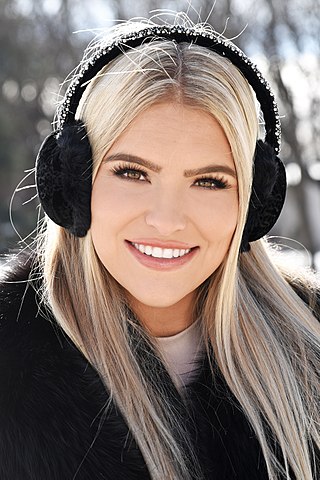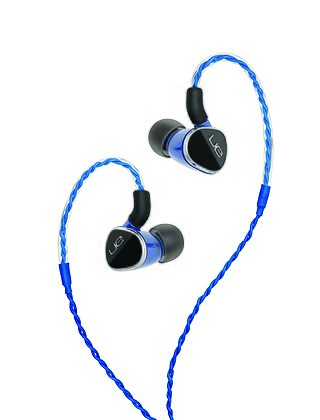
Binaural recording is a method of recording sound that uses two microphones, arranged with the intent to create a 3D stereo sound sensation for the listener of actually being in the room with the performers or instruments. This effect is often created using a technique known as dummy head recording, wherein a mannequin head is fitted with a microphone in each ear. Binaural recording is intended for replay using headphones and will not translate properly over stereo speakers. This idea of a three-dimensional or "internal" form of sound has also translated into useful advancement of technology in many things such as stethoscopes creating "in-head" acoustics and IMAX movies being able to create a three-dimensional acoustic experience.

Headphones are a pair of small loudspeaker drivers worn on or around the head over a user's ears. They are electroacoustic transducers, which convert an electrical signal to a corresponding sound. Headphones let a single user listen to an audio source privately, in contrast to a loudspeaker, which emits sound into the open air for anyone nearby to hear. Headphones are also known as earphones or, colloquially, cans. Circumaural and supra-aural headphones use a band over the top of the head to hold the drivers in place. Another type, known as earbuds or earpieces, consists of individual units that plug into the user's ear canal. A third type are bone conduction headphones, which typically wrap around the back of the head and rest in front of the ear canal, leaving the ear canal open. In the context of telecommunication, a headset is a combination of a headphone and microphone.

Active noise control (ANC), also known as noise cancellation (NC), or active noise reduction (ANR), is a method for reducing unwanted sound by the addition of a second sound specifically designed to cancel the first. The concept was first developed in the late 1930s; later developmental work that began in the 1950s eventually resulted in commercial airline headsets with the technology becoming available in the late 1980s. The technology is also used in road vehicles, mobile telephones, earbuds, and headphones.

A hearing aid is a device designed to improve hearing by making sound audible to a person with hearing loss. Hearing aids are classified as medical devices in most countries, and regulated by the respective regulations. Small audio amplifiers such as personal sound amplification products (PSAPs) or other plain sound reinforcing systems cannot be sold as "hearing aids".

An earplug is a device that is inserted in the ear canal to protect the user's ears from loud noises, intrusion of water, foreign bodies, dust or excessive wind. Since they reduce the sound volume, earplugs may prevent hearing loss and tinnitus, in some causes.

Earmuffs are clothing accessories or personal protective equipment designed to cover a person's ears for hearing protection or warmth. They consist of a thermoplastic or metal head-band that fits over the top or back of the head, and a cushion or cup at each end to cover the ears.
Shure Incorporated is an audio products corporation headquartered in the USA. It was founded by Sidney N. Shure in Chicago, Illinois, in 1925 as a supplier of radio parts kits. The company became a consumer and professional audio-electronics manufacturer of microphones, wireless microphone systems, phonograph cartridges, discussion systems, mixers, and digital signal processing. The company also manufactures listening products, including headphones, high-end earphones, and personal monitor systems.

Ultimate Ears is an American custom in-ear monitor (IEM), speaker, and earphone manufacturer based in Irvine and Newark, California, United States.

In-ear monitors, or simply IEMs or in-ears, are devices used by musicians, audio engineers and audiophiles to listen to music or to hear a personal mix of vocals and stage instrumentation for live performance or recording studio mixing. They are also used by television presenters to receive vocal instructions, information and breaking news announcements from a producer that only the presenter hears. They are often custom-fitted to an individual's ears to provide comfort and a high level of noise reduction from ambient surroundings. Their origins as a tool in live music performance can be traced back to the mid-1980s.
Acoustic quieting is the process of making machinery quieter by damping vibrations to prevent them from reaching the observer. Machinery vibrates, causing sound waves in air, hydroacoustic waves in water, and mechanical stresses in solid matter. Quieting is achieved by absorbing the vibrational energy or minimizing the source of the vibration. It may also be redirected away from the observer.
A noise-canceling microphone is a microphone that is designed to filter ambient noise.

A headset is a combination of headphone and microphone. Headsets connect over a telephone or to a computer, allowing the user to speak and listen while keeping both hands free. They are commonly used in customer service and technical support centers, where employees can converse with customers while typing information into a computer. They are also common among computer gamers and let them talk with each other and hear others while using their keyboards and mice to play the game.

Apple Inc. has produced and sold headphones since 2001, available for standalone purchase and bundled with iPhone and iPod products. Apple's current product line consists of EarPods, AirPods and AirPods Pro, and AirPods Max.

UE 900 and UE 900S are noise-isolating earphones manufactured and marketed by Logitech, under the Ultimate Ears brand. They are aimed at listeners who prefer neutral sound signature. They are rated as one of the best ear phones in its price range by CNET.

TV Ears is an American, privately held audio technology company that specializes in voice clarifying television products for the hearing impaired. It was founded in April 1998 by George Dennis. They are located in Spring Valley, California, where they house the North American distribution center, support, and sales teams, while employing approximately 50 people. TV Ears serves hearing impaired customers throughout the world, with their predominant markets being in the United States, Canada, and Europe.

Hearing protector fit-testing measures the degree of noise reduction obtained from an individual wearing a particular hearing protection device (HPD) - for example, an earplug or earmuff. Such measurements are necessary because noise attenuation varies across individuals due to anatomical differences and inadequate training as to the proper wear and use. Labeled HPD attenuation values are average values that cannot predict noise attenuation for an individual; in addition, they are based on laboratory measurements which may overestimate the noise reduction obtained in the real world.

AirPods Pro are wireless Bluetooth in-ear headphones designed by Apple, initially introduced on October 30, 2019. They are Apple's mid-range wireless headphones, available alongside the base-level AirPods and the highest-end AirPods Max.
Huawei FreeBuds are wireless Bluetooth and NearLink earbuds. They were first announced and released on March 27, 2018, alongside Huawei P20 series. In addition to playing audio, the Huawei FreeBuds contains a microphone that filters out background noises as well as built-in accelerometers and optical sensors capable to detect taps and pinches and placement within the ear, which enables automatic pausing of audio when they are taken out of the ear.















